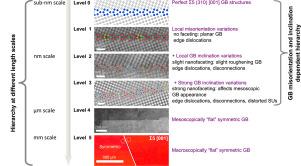Hierarchy of defects in near-Σ5 tilt grain boundaries in copper studied by length-scale bridging electron microscopy
IF 9.3
1区 材料科学
Q1 MATERIALS SCIENCE, MULTIDISCIPLINARY
引用次数: 0
Abstract
Grain boundaries (GBs) are material imperfections that significantly impact material properties. Understanding how their atomic structure deviates from ideal symmetric orientations is crucial for establishing fundamental structure–property relationships. In this study, we utilized aberration-corrected scanning transmission electron microscopy, geometric phase analysis and nanobeam electron diffraction (NBED) to examine the structure of a series of near- tilt grain boundaries in copper and to explore the formation of GB defects and their associated strain field evolution on different length scales. Globally, the GB appears flat with no noticeable defects, as confirmed by NBED strain mapping. On the atomic-scale, however, various types of GB defects are observed. When a slight deviation in the misorientation is introduced, a patterning emerges featuring characteristic structural units from the and tilt boundaries. This pattern can be interpreted as secondary GB dislocations, a conclusion that is supported by GB structure prediction. Since these defects are confined to within the GB core, their associated strain field does not extend into the adjacent bulk grains. The structural landscape of the GB becomes more complex when GB plane inclination is also present, such as a wavy morphology or staircase-like architecture. The wavy morphology shows an unusual V-shape of the expansion and compression zones of the GB facet junctions that continue to extend into the bulk crystals for several nanometers. Our investigation into GB structure, particularly its inherent defects, is a prerequisite towards gaining atomic-scale insights into their potential impact on material properties.


用长度尺度桥接电镜研究铜在-Σ5倾斜晶界附近缺陷的层次
晶界(GBs)是影响材料性能的材料缺陷。了解它们的原子结构如何偏离理想的对称取向对于建立基本的结构-性质关系至关重要。在本研究中,我们利用像差校正扫描透射电镜、几何相位分析和纳米束电子衍射(NBED)研究了铜中一系列接近-Σ5(310)[001]Σ5(310)[001]倾斜晶界的结构,并探讨了不同长度尺度下GB缺陷的形成及其相关的应变场演化。从整体上看,国标是平坦的,没有明显的缺陷,正如NBED应变图所证实的那样。然而,在原子尺度上,可以观察到各种类型的GB缺陷。当引入取向错误的轻微偏差时,出现具有来自Σ5(310)[001]Σ5(310)[001]和Σ5(210)[001]倾斜边界的特征结构单元的图案。这种模式可以解释为二次位错,这一结论得到了GB结构预测的支持。由于这些缺陷被限制在GB芯内,它们的相关应变场不会扩展到相邻的大块晶粒中。当GB平面倾斜也存在时,GB的结构景观变得更加复杂,如波浪状形态或阶梯状建筑。波状形貌显示出一个不寻常的v形的GB面结的膨胀和压缩区,继续延伸到体晶体数纳米。我们对GB结构的研究,特别是其固有缺陷的研究,是获得原子尺度上对材料性能潜在影响的先决条件。
本文章由计算机程序翻译,如有差异,请以英文原文为准。
求助全文
约1分钟内获得全文
求助全文
来源期刊

Acta Materialia
工程技术-材料科学:综合
CiteScore
16.10
自引率
8.50%
发文量
801
审稿时长
53 days
期刊介绍:
Acta Materialia serves as a platform for publishing full-length, original papers and commissioned overviews that contribute to a profound understanding of the correlation between the processing, structure, and properties of inorganic materials. The journal seeks papers with high impact potential or those that significantly propel the field forward. The scope includes the atomic and molecular arrangements, chemical and electronic structures, and microstructure of materials, focusing on their mechanical or functional behavior across all length scales, including nanostructures.
 求助内容:
求助内容: 应助结果提醒方式:
应助结果提醒方式:


